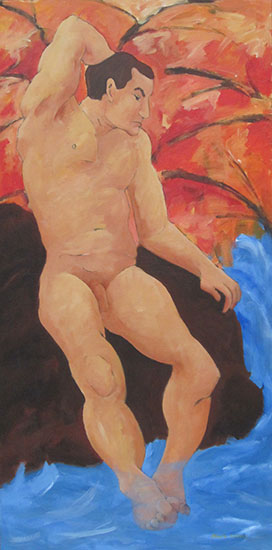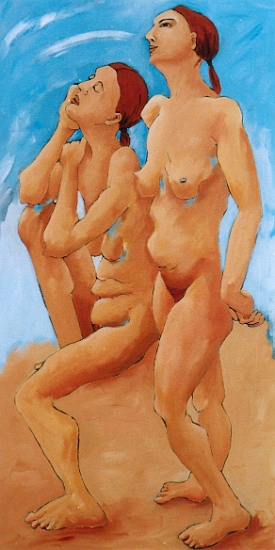Beauty and the clown
Mieke Koenen paints human beings. Standing, sitting, lying and walking, beautiful and ugly, young and old. Starting point for every piece is a life model. She looks at what appeals to her through insight and emotion, draws her model and elaborates it to a painting. Sometimes she sticks to one figure, often she merges more figure studies, of the same model or of various models, to one composition.
In fact all these pictures show something of Mieke’s outlook on life. Mieke Koenen has miscellaneous feelings on life. Sometimes there is a somewhat humorous acquiescence in reality. She has a series of paintings, on which we see two naked ladies, closely observing each other, with the title: ‘It’s not too bad’ In another we see Eve and Adam who, after eating the apple, look rather depressed now their relationship is severely under pressure. The title explains what causes the irritation ’Blame me again!’ Here we taste the ironic acceptance of the human shortcoming, which gives nice accents to the paintings of the artist. Something similar we also see in other traditional subjects like: ’The three graces’ or ‘Pandora’. Pandora, who is commanded by the Greek gods to bring evil to the human race, sits there as a dull goose who can do nothing about it.
And often the graces are not as graceful as the title promises. Sometimes they are painted as men, because Mieke Koenen does not adhere to traditional gender casting.
The paintings of Koenen are a constant meditation on what the French call: ‘la condition humaine’. Her pictures are brought about between two extremes. On the one hand the utopian scheme of paradise: beautifully coloured models bathing in warm light and in harmony with their surroundings. On the other hand there is the pitiless reproduction of humans, whose potbelly and greasiness betray that they are resigned to the laws of gravity; and who will always have problems to build up a balanced relationship with the surrounding world. When she reduces man to a caricature of himself, then that is because it is her way to accept with humour and mockery the human imperfection. She makes fun of the traditional image of man and woman and of their relationship. Mankind becomes a clown, but one who in all his clumsiness has something human.
Dr. Leo Ewals, art-historian



